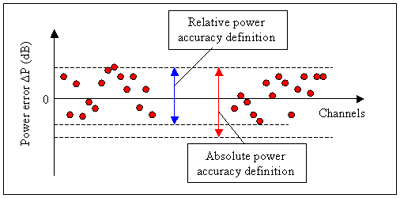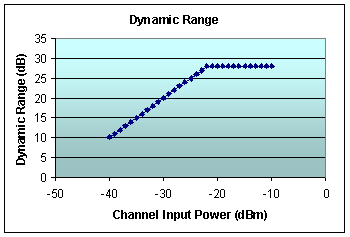Parameter
Definition |
Example |
Wavelength Range (nm) is defined as wavelength range over
which the Optical Performance Monitor (OPM)
or Optical Channel Monitor (OCM)
can measure the power and wavelength of the optical channels. |
1530.33 - 1563.05 nm |
Channel
Number is the total number of channels defined in
a channel plan that the OPM / OCM can identify. |
42 |
Channel
Spacing (GHz) is the equal frequency separation
between two neighboring channels in DWDM system. |
100 GHz |
Input Wavelength Tolerance (GHz) defines the
maximally allowed deviation of input laser away from ITU grid or channel
plan. This parameter defines the minimum channel spacing. For example, for
Input wavelength tolerance = ±5 GHz, channel spacing = 50 GHz, the minimum
channel spacing will be 40 GHz in the worst case. |
±5 GHz |
Adjacent Channel Power Difference (dB) is maximum power difference between any two adjacent channels |
12 dB |
Non-adjacent
Channel Power Difference (dB) is maximum power
difference between any two non-adjacent channels |
20 dB |
Maximum
Input Power (dBm) is total input optical power
of all channels that is allowed to the OPM. |
23 dBm |
Channel
Input Power Range (dBm) is the measurement
power range of each channel when power and wavelength can be correctly
reported. |
-40 to -10 dBm |
Absolute
Channel Power Accuracy (dB) is defined as ±Max
(|DPi|)
over all the channels and operating temperature range, where DPi is the power
measurement error against a calibrated power meter for the channel i. |
± 0.5 dB |
Relative Channel Power
Accuracy (dB) is defined as the difference
between the maximum and the minimum values of the power measurement error
data across Spectral Range (all channels) at a measurement temperature. The
worst-case value over all temperatures is used to specify Relative Channel
Power Accuracy.  |
0.6 dB |
Power
Measurement Repeatability (dB) is the variation of
a channel power measurement on a 1-minute interval at fixed peak power and
polarization and at a constant temperature. |
± 0.1 dB |
PDL (dB) is the power difference between the two extreme polarization
states. |
0.3 dB |
Absolute
Wavelength Accuracy (pm) is defined as ±Max
(|Dli|) over all the channels and operating temperature range, where Dli is the wavelength measurement error against a calibrated wavelength meter for
the channel i. |
± 50 pm |
Relative
Wavelength Accuracy (pm) is defined as the
difference between the maximum and the minimum values of the wavelength
measurement error data across Spectral Range (all channels) at a measurement
temperature. The worst-case value over all temperatures is used to specify
Relative Wavelength Accuracy. |
60 pm |
OSNR (dB) is measured as the ratio of a coherent
signal power to a band-limited broadband noise source, normalized to 0.1-nm
spectral window. |
28 dB |
Maximum OSNR (dB) is the highest OSNR that can be measured and still meet the OSNR
accuracy and repeatability requirements. Its value depends on the input
channel power level, noise floor, and filter isolation. See a typical example
in the graph.

|
28 dB |
OSNR Range is the maximum and minimum OSNR values, within which OPM can report OSNR
with OSNR error < OSNR Accuracy. |
10 ~ 25 dB |
OSNR Accuracy (dB) is defined as ±Max (|DOSNRi|) over all the channels and operating temperature
range, where DOSNRi is the OSNR measurement error against a calibrated Optical Spectrum Analyzer
for the channel i. |
± 1.5 dB |
Noise
Floor (dBm) is defined as electronics noise
without light input. |
-60 dBm |
Optical
Return Loss (dB) is the ratio between the input
power and the reflected power over all polarization states at each port, RL =
-10×log10(Pr/Pin). |
40 dB |
Response
Time (ms) is the time required to perform the
measurements of OSNR, power, and wavelength for all channels and transfer
these values over the communications interface to the central controller. |
500 ms |
Power
Consumption (W) is defined as peak electrical
power when the OPM operates. |
2 W |
Operating
Temperature (°C) is the ambient temperature
range over which the device can be operated and maintain its specifications. |
-5 to 65 °C |
Storage
Temperature (°C) is the ambient temperature
range over which the device can be stored without damage and can be operated
over operating temperature according to its specifications. |
-40 to 85 °C |